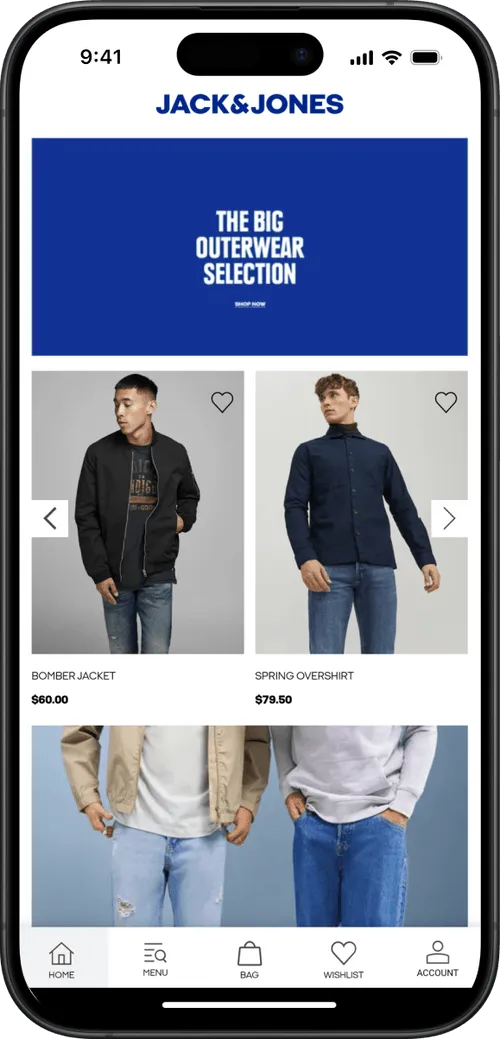What is Total Cost of Ownership for Mobile Apps (And Why Does It Matter?)
Total Cost of Ownership (TCO) includes everything from development and maintenance to updates, compliance, and lost revenue from poor performance.
Cheaper options cost you in missed sales and eventual rebuilds. Agencies and in-house teams offer flexibility but come with sky-high long-term costs. MobiLoud delivers a lower, more predictable TCO by turning your existing site into an app, handling updates, and ensuring feature parity from day one.
Total Cost of Ownership (TCO) includes everything from development and maintenance to updates, compliance, and lost revenue from poor performance.
Cheaper options cost you in missed sales and eventual rebuilds. Agencies and in-house teams offer flexibility but come with sky-high long-term costs. MobiLoud delivers a lower, more predictable TCO by turning your existing site into an app, handling updates, and ensuring feature parity from day one.
When you’re planning a mobile app, it’s easy to look only at the upfront price tag. Maybe it’s the monthly fee for an app builder, or a quote from an agency. But that number doesn’t tell the whole story.
The real cost of a mobile app is the Total Cost of Ownership (TCO).
This goes beyond what you pay to build or subscribe. It includes everything it takes to keep your app running, updated, and delivering value over time.
Understanding TCO matters because the cheapest option at first glance can end up being the most expensive once you factor in maintenance, updates, and lost revenue from poor performance.
In this article, we’ll break down what TCO means for mobile apps, why it’s critical to factor into your decision-making, and how different options stack up when you look at the full picture.
What is Total Cost of Ownership (TCO)?
Total Cost of Ownership (TCO) is the complete cost of running a mobile app over its entire life cycle.
It’s not just what you pay to create an app. It’s everything it takes to keep it live, functional, and delivering value for your business.
What TCO Includes for Mobile Apps
When you look at mobile apps through a TCO lens, you need to consider:
- Development or build costs: the upfront expense of using an app builder, hiring an agency, or building in-house.
- Design and customization: UI/UX tweaks, brand integration, and added features.
- Infrastructure: servers, APIs, third-party services, and hosting.
- App store compliance: Apple/Google developer accounts, review resubmissions, and mandatory updates.
- Ongoing maintenance: bug fixes, OS compatibility updates, security patches.
- Team and overhead: whether you need developers on retainer or in-house staff to manage the app.
- Opportunity costs: lost revenue from downtime, missing features, or a poor user experience that reduces conversions.
Bottom line: TCO gives you the real financial picture of an app, not just the sticker price.
Why Does TCO Matter?
When you only focus on upfront price, you risk underestimating the true cost.
That mistake can slow growth, hurt retention, and erode ROI.
Why this matters for your business:
- Price ≠ Cost. A $20k agency build or a $500/month app builder is only part of the story. Once you add updates, fixes, and maintenance, the numbers look very different.
- Hidden costs add up. Cheaper options often mean cutting corners. That can lead to extra development down the line, higher maintenance bills, or lost sales from a clunky experience.
- Apps are living products. iOS and Android constantly update. Devices evolve. Customer expectations grow. Every change requires upkeep.
- For online stores, every bug, crash, or missing feature isn’t just a tech issue. It’s lost conversions and reduced lifetime value.
Bottom line: the price you see upfront is rarely the true cost of an app. Total Cost of Ownership reveals the full financial commitment over time.
How to Evaluate Mobile App Options by TCO
If you’re in the market for a mobile app, TCO needs to be one of the primary factors you build your decision around.
When you evaluate mobile app solutions with TCO in mind, you’ll avoid surprises and choose the option that’s truly cost-effective in the long run.
However, it can be difficult. TCO isn’t listed on the box. It typically requires some manual estimation, beyond the quote you get from an agency, or the number on a pricing table.
Here’s how to understand the TCO of any app development approach you’re considering:
A Blueprint for Calculating TCO
- Map your app’s lifecycle. Think beyond launch. Consider what the app will cost to maintain over 1–3 years (updates, compliance, user growth).
- Break it down into cost categories. Include development, infrastructure, maintenance, app store fees, QA, and team costs.
- Estimate any hidden costs. Look for risks like rebuilds, downtime, lost conversions from poor UX, or expensive add-ons later.
- Normalize the comparisons. Put each option on the same timeline (e.g., three years). Compare total spend, not just upfront prices.
- Match with your goals. Tie the numbers back to outcomes: Will this option improve retention, conversions, and lifetime value, or hold you back?
Bottom line: TCO is less about the sticker price and more about the real costs of sustaining an app as a growth channel. And this is likely something you’ll have to calculate on your own.
Comparing TCO Across Different App Development Options
When you break it down, you’ll see a significant difference between different approaches.
And the most cost-effective app development options may not be what you think.
Here’s how the main options stack up, and the main factors influencing TCO.
DIY No-Code App Builders
The appeal:
DIY and no-code app builders look attractive at first glance. For $100–$500/month, you can launch an app without writing a single line of code. For a small ecommerce brand, the promise of speed and affordability can be hard to resist.
The reality once you factor in TCO:
- Upfront costs: Low. You might pay a setup fee and a recurring subscription.
- Customization limits: These platforms rely on templates. Anything outside of their prebuilt features can be impossible or expensive to achieve.
- Maintenance burden: The builder takes care of the basics, but you’ll still run into gaps — bugs, performance issues, or design changes that require workarounds.
- Feature gaps: Many DIY apps can’t replicate the complexity of modern ecommerce sites. This leads to opportunity costs in the form of lost conversions and lower customer lifetime value.
- Scalability issues: As your store grows, you’ll hit ceilings. Adding new features or integrations may require a costly migration to a custom solution later.
Biggest factors in the TCO of no-code app builders:
- Subscription fees (usually predictable and fixed).
- Design and customization costs when you need workarounds or agency help.
- Maintenance and bug fixes not fully covered by the platform.
- Opportunity cost from missing ecommerce features (e.g., custom checkout flows, advanced loyalty programs, upsells).
- Migration/rebuild costs if you eventually outgrow the platform and have to start over.
Final TCO takeaway:
On paper, DIY builders look cheap. But once you factor in limited functionality, lost revenue from poor UX, and the eventual cost of moving to another platform, the long-term ownership cost can be far higher than the sticker price suggests.
Custom Development (via Agencies)
The appeal:
Hiring an agency gives you a ready-made expert team. They handle everything; scoping, design, development, testing, and app store submission. The promise is a polished, custom app tailored to your brand.
The reality once you factor in TCO:
- Upfront costs: High. Most ecommerce apps built by agencies start at $25k–$50k, with many quotes running well into six figures.
- Maintenance retainers: Agencies typically charge monthly or yearly retainers for bug fixes, OS updates, and new features. Without this, your app can quickly break when Apple or Google release new OS versions.
- Dependency risk: You’re locked into the agency’s timeline, availability, and pricing. Simple changes can take weeks and cost thousands.
- Slow ROI: Long timelines (often 6–12 months) delay launch and revenue impact.
- Scalability costs: Every new feature requires a new project (and another round of invoices).
Biggest factors in the TCO of agency-built apps:
- Large upfront build cost ($25k–$100k+).
- Ongoing retainer fees for maintenance and updates.
- Change request costs for new features or fixes.
- Time-to-market delays, which represent opportunity cost in missed revenue.
- Vendor lock-in, limiting flexibility and driving long-term costs higher.
Final TCO takeaway:
Agencies deliver professional apps but at a steep total cost. For most ecommerce brands, this path is only viable with very large budgets and a tolerance for ongoing dependency on outside developers.
Custom Development In-House
The appeal:
Building your own team gives you full control. You own the code, set the roadmap, and customize every detail to your exact needs. On the surface, it feels like the most flexible and scalable option.
The reality once you factor in TCO:
- Upfront investment: Hiring skilled developers, designers, and product managers is expensive. Even a small team can run $250k+ per year in salaries.
- Ongoing costs: Payroll doesn’t go away. Every bug, update, and new feature adds to your team’s workload.
- Recruitment and churn: Developers leave. Replacing them costs time and money. Institutional knowledge is lost, driving costs up further.
- Opportunity costs: Your team’s time is finite. Every hour spent on maintaining the app is time not spent on core ecommerce improvements.
- High risk: Unless you’re already a tech company, managing an in-house app team stretches resources thin.
Biggest factors in the TCO of in-house development:
- Salaries and benefits for developers, designers, and QA.
- Recruitment and training costs when staff churn.
- Infrastructure costs (servers, tools, monitoring).
- Ongoing maintenance workload for OS updates and bug fixes.
- Opportunity cost of time taken away from growth-driving ecommerce work.
Final TCO takeaway:
In-house development gives the most control but comes with the highest ongoing ownership cost. You not only need to manage the project and pay the developers, but you also become responsible for benefits and HR-related costs. For non-technical ecommerce brands, it often means massive overhead with limited payoff.
MobiLoud (Website-to-App Approach)
The appeal:
MobiLoud takes a different path. Instead of rebuilding your app from scratch, it converts your existing website into fully branded iOS and Android apps.
You keep all your site’s functionality, while we handle the heavy lifting of app conversion, publishing, and maintenance.

Many brands come to us (and stay with us) specifically for the low TCO. A fully-managed, white-glove service means the number you see on the pricing table is as close as it comes to the true cost of ownership.
The reality once you factor in TCO:
- Upfront costs: Much lower than custom development, since you don’t need to rebuild your web experience in a new environment. Apps launch in weeks, not months.
- Maintenance included: MobiLoud takes care of OS updates, app store compliance, and ongoing technical support — eliminating one of the largest hidden costs of other approaches.
- Feature parity from day one: Because your site powers the app, everything that works on your website works in the app. No expensive rebuilds or missed features that cause lost revenue.
- Reduced opportunity cost: Launching faster means you capture revenue and retention benefits sooner. Avoiding feature gaps means fewer lost sales compared to DIY builders.
- Predictable spend: Pricing is transparent and ongoing costs are clear, unlike agencies or in-house dev teams where bills spike with every change.
Biggest factors in the TCO of MobiLoud apps:
- Initial setup cost (significantly lower than agency builds).
- Predictable subscription that includes hosting, support, and maintenance.
- Time-to-market savings — launching in weeks vs. months translates into earlier ROI.
- No rebuild costs — your site already powers the app.
- Reduced opportunity costs — full feature parity avoids the lost sales common with limited DIY builders.
Final TCO takeaway:
MobiLoud offers the most cost-efficient long-term ownership model for ecommerce brands. You avoid the heavy upfront cost of agencies, the long-term payroll of in-house teams, and the revenue-killing limitations of DIY builders. At the same time, you get a fully functional app live in just a few weeks, with no feature gaps compared to your website.
Want to see what’s possible? Get a free preview of your app, and we’ll show you a working prototype of your site as an app.
Conclusion: Why TCO Should Guide Your Decision-Making Process
When it comes to mobile apps, the price tag is just the beginning. The real cost is in the Total Cost of Ownership — everything it takes to keep your app running, updated, and delivering results over time.
- DIY builders look cheap but often bleed value through missing features, poor UX, and eventual rebuilds.
- Agencies deliver polished apps, but at a steep total cost, with ongoing retainers and long timelines.
- In-house development gives control, but the overhead and payroll make it viable only for tech-driven companies.
- MobiLoud offers a lower, more predictable TCO by turning your existing site into an app, handling updates, and ensuring feature parity from day one.
Bottom line: TCO isn’t just an accounting exercise. It’s about protecting your ROI and making sure your mobile app is an asset, not a liability.
If you’re considering an app for your ecommerce business, don’t stop at the sticker price. Look at the full cost of ownership. You’ll see why MobiLoud is the smarter, more sustainable way to launch your own app.
Talk to us about launching your app with MobiLoud. We’ll do the heavy lifting, get you live in weeks, and help you grow with a lower total cost of ownership.
Curious? Get a free consultation now.
FAQs
Convert your website into a mobile app












